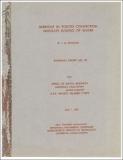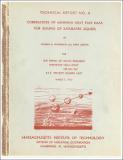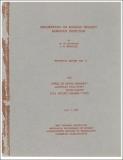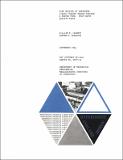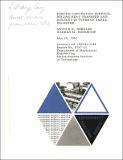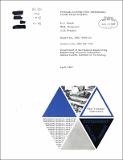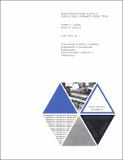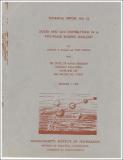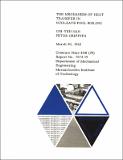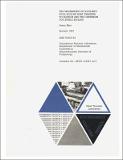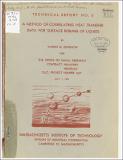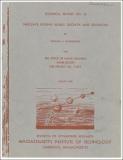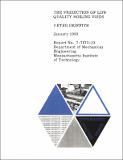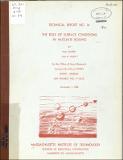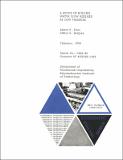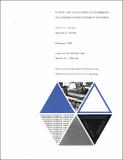Browsing Heat Transfer Laboratory by Subject "Boiling-points."
Now showing items 1-20 of 23
-
Boiling and condensation in a liquid-filled enclosure
(Cambridge, Mass. : M.I.T. Heat Transfer Laboratory, [1971], 1971)A combined experimental and analytical investigation of boiling and condensation in a liquid-filled enclosure, with water and Freon- 113 as the working fluids, is described. The operating characteristics of a boiling system, ... -
Burnout in forced convection nucleate boiling of water
(Cambridge, Mass. : M.I.T. Heat Transfer Laboratory, [1957], 1957)Data are presented for burnout in forced coivection nucleate boiling of water at pressures above 500 psia. A dimensionless correlation is devised for. the M.I.T. data which is found to be valid for certain recent data ... -
Correlation of maximum heat flux data for boiling of saturated liquids
(Cambridge, Mass. : Massachusetts Institute of Technology, Division of Industrial Cooperation, [1955], 1955) -
Description of boiling project burnout detector
(Cambridge, Mass. : M.I.T. Heat Transfer Laboratory, [1957], 1957)Introduction: In order to effectively utilize the high heat flux available through the mechanism of nucleate boiling in forced convection heat transfer, it is of primary importance that the maximum flux or "burnout" ... -
Film boiling of saturated liquid flowing upward through a heated tube : high vapor quality range
(Cambridge, Mass. : M.I.T. Dept. of Mechanical Engineering, [1964], 1964)Film boiling of saturated liquid flowing upward through a uniformly heated tube has been studied for the case in which pure saturated liquid enters the tube and nearly saturated vapor is discharged. Since a previous study ... -
Forced-convection surface-boiling heat transfer and burnout in tubes of small diameters
(Cambridge, Mass. : M.I.T. Dept. of Mechanical Engineering, [1962], 1962)A basic heat-transfer apparatus was designed and constructed for the study of forced-convection boiling in small channels. The various regions of forced-convection surface boiling were studied experimentally and analytically. ... -
Forced-convection, dispersed-flow film boiling
(Cambridge, Mass. : M.I.T. Dept. of Mechanical Engineering, [1969], 1969)This report presents the latest results of an investigation of the characteristics of dispersed flow film boiling. Heat transfer data are presented for vertical upflow of nitrogen in an electrically heated tube, 0.4 in. ... -
Heat transfer and pressure drop in tape generated swirl flow
(Cambridge, Mass. : M.I.T. Dept. of Mechanical Engineering, [1967], 1967)The heat transfer and pressure drop characteristics of water in tape generated swirl flow were investigated. The test sections were electrically heated small diameter nickel tubes with tight fitting full length Inconel ... -
Liquid and gas distributions in a two-phase boiling analogy
(Cambridge, Mass. : Massachusetts Institute of Technology, Division of Industrial Cooperation, [1958], 1958)This report contains a description of the design and operation of an experimental appats for the analysis of two-phase flows similar to thom occuwring in boiler tubes at low pressures. Velocity and denuity profiles of ... -
The mechanism of heat transfer in nucleate pool boiling
(Cambridge, Mass. : M.I.T. Division of Sponsored Research, [1962], 1962)A criterion is developed for bubble initiation from a gas filled cavity on a surface in contact with a superheated layer of liquid. It is found that the temperature of bubble initiation on a given surface is a function of ... -
Mechanism of nucleate pool boiling heat transfer to sodium and the criterion for stable boiling
(Cambridge, Mass. : M.I.T. Engineering Projects Laboratory, [1967], 1967)A comparison between liquid metals and other common fluids, like water, is made as regards to the various stages of nucleate pool boiling. It is suggested that for liquid metals the stage of building the thermal layer plays ... -
A method of correlating heat transfer data for surface boiling of liquids
(Cambridge, Mass. : M.I.T. Division of Industrial Cooporation, [1951], 1951)A method based an a logical uxplanation of the meani of beat transfer associated with the boiling process is presented for correlating heat transfer data for nucleate boiling of liquids for the case of pool boiling. Tbe ... -
Model of critical heat flux in subcooled flow boiling
(Cambridge, Mass. : M.I.T. Dept. of Mechanical Engineering, [1968], 1968)The physical phenomenon occurring before and at the critical heat flux (CHF) for subcooled flow boiling has been investigated. The first phase of this study established the basic nature of the flow structure at CHF. A ... -
Natural convection flows in parallel connected vertical channels with boiling
(Cambridge, Mass. : M.I.T. Dept. of Mechanical Engineering, [1967], 1967)The steady-state flow configuration in an array of parallel heated channels is examined with the objective of predicting the behavior of a reactor during a loss of flow accident. A method of combining the results of single ... -
Nucleate boiling bubble growth and departure
(Cambridge, Mass. : Massachusetts Institute of Technology, Division of Industrial Cooperation, [1959], 1959)The vapor bubble formation on the heating surface during pool boiling has been studied experimentally. Experiments were made at the atmospheric pressure 28 psi and 40 psi, using degassed distilled water and ethanol. The ... -
The prediction of low quality boiling voids
(Cambridge, Mass. : M.I.T. Division of Sponsored Research, [1963], 1963)Slug flow theory is used to predict the density in heated channels of various shapes. In order to make this calculation possible, measurements are made of the bubble rise velocity in annuli, tube bundles, and channels. It ... -
The role of surface conditions in nucleate boiling
(Cambridge, Mass. : Massachusetts Institute of Technology, Division of Industrial Cooperation, [1958], 1958)Nucleation from a single cavity has been stuied indicating that cavity gemtry is aportant in two ways. The mouth diameter determines the superheat nmeded to initiate boiling and its shape determines its stability one boiling ... -
A study of boiling water flow regimes at low pressures
(Cambridge, Mass. : M.I.T. Dept. of Mechanical Engineering, [1966], 1966)"A comprehensive experimental program to examine flow regimes at pressures below 100 psia for boiling of water in tubes was carried out. An electrical probe, which measures the resistance of the fluid between the centerline ... -
A study of system-induced instabilities in forced-convection flows with subcooled boiling
(Cambridge, Mass. : M.I.T. Dept. of Mechanical Engineering, [1965], 1965)A combined analytical and experimental program was carried out to investigate the problem of hydrodynamic stability of forcedconvection flows with boiling. The study was restricted to the flow of water in small channels ... -
Survey and evaluation of techniques to augment convective heat transfer
(Cambridge, Mass. : M.I.T. Dept. of Mechanical Engineering, [1965], 1965)This report presents a survey and evaluation of the numerous techniques which have been shown to augment convective heat transfer. These techniques are: surface promoters, including roughness and treatment; displaced ...

